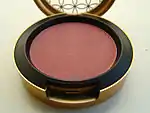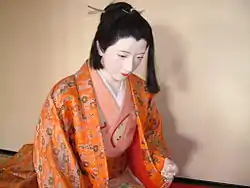紅
| ||||||||
Translingual
Han character
紅 (Kangxi radical 120, 糸+3, 9 strokes, cangjie input 女火一 (VFM), four-corner 21910, composition ⿰糹工)
References
- KangXi: page 916, character 1
- Dai Kanwa Jiten: character 27243
- Dae Jaweon: page 1343, character 8
- Hanyu Da Zidian (first edition): volume 5, page 3363, character 5
- Unihan data for U+7D05
Chinese
| trad. | 紅 | |
|---|---|---|
| simp. | 红 | |
Glyph origin
| Historical forms of the character 紅 |
|---|
| Shuowen Jiezi (compiled in Han) |
| Small seal script |
 |
| Old Chinese | |
|---|---|
| 缸 | *kroːŋ, *ɡroːŋ |
| 篢 | *kluːmʔ, *koːŋ |
| 贑 | *kluːmʔ |
| 涳 | *ŋr'oːŋ, *kʰroːŋ, *kʰoːŋ |
| 江 | *kroːŋ |
| 肛 | *kroːŋ, *qʰroːŋ |
| 扛 | *kroːŋ |
| 杠 | *kroːŋ |
| 豇 | *kroːŋ |
| 茳 | *kroːŋ |
| 釭 | *kroːŋ, *koːŋ, *kuːŋ |
| 矼 | *kroːŋ |
| 玒 | *kroːŋ, *koːŋ |
| 虹 | *kroːŋs, *koːŋs, *ɡoːŋ |
| 腔 | *kʰroːŋ |
| 崆 | *kʰroːŋ, *kʰoːŋ |
| 羫 | *kʰroːŋ |
| 控 | *kʰroːŋ, *kʰoːŋs |
| 椌 | *kʰroːŋ, *kʰoːŋ |
| 悾 | *kʰroːŋ, *kʰoːŋ, *kʰoːŋs |
| 跫 | *kʰroːŋ, *kʰoŋ, *ɡoŋ |
| 啌 | *qʰroːŋ |
| 谾 | *qʰroːŋ, *qʰoːŋ |
| 舡 | *qʰroːŋ |
| 缻 | *ɡroːŋ |
| 項 | *ɡroːŋʔ |
| 屸 | *ɡ·roːŋ |
| 功 | *koːŋ |
| 工 | *koːŋ |
| 疘 | *koːŋ |
| 魟 | *koːŋ, *qʰoːŋ, *ɡoːŋ |
| 攻 | *koːŋ, *kuːŋ |
| 愩 | *koːŋ |
| 碽 | *koːŋ |
| 貢 | *koːŋs |
| 羾 | *koːŋs |
| 空 | *kʰoːŋ, *kʰoːŋs |
| 箜 | *kʰoːŋ |
| 硿 | *kʰoːŋ |
| 埪 | *kʰoːŋ |
| 鵼 | *kʰoːŋ |
| 倥 | *kʰoːŋ, *kʰoːŋʔ, *kʰoːŋs |
| 鞚 | *kʰoːŋs |
| 叿 | *qʰoːŋ |
| 嗊 | *qʰoːŋʔ |
| 訌 | *ɡoːŋ |
| 紅 | *ɡoːŋ |
| 仜 | *ɡoːŋ |
| 葒 | *ɡoːŋ |
| 渱 | *ɡoːŋ |
| 鴻 | *ɡoːŋ, *ɡoːŋʔ |
| 汞 | *ɡoːŋʔ |
| 澒 | *ɡoːŋʔ |
| 鞏 | *koŋʔ |
| 巩 | *koŋʔ |
| 銎 | *kʰoŋ, *qʰoŋ |
| 恐 | *kʰoŋʔ, *kʰoŋs |
| 蛩 | *ɡoŋ |
| 筇 | *ɡoŋ |
| 桏 | *ɡoŋ |
| 邛 | *ɡoŋ |
Phono-semantic compound (形聲, OC *ɡoːŋ) : semantic 糸 (“silk”) + phonetic 工 (OC *koːŋ).
Etymology
彤 (OC *l'uːŋ, “red”) could be a variant of 紅 (OC *ɡoːŋ) (Schuessler, 2007). May be related to 虹 (OC *kroːŋs, *ɡoːŋ, “rainbow”).
Originally referred to lighter shades of red; gradually replaced 赤 (chì, “red”) as the basic color term for "red".
Pronunciation 1
Definitions
紅
- red
- 紅色/红色 ― hóngsè ― red (color)
- 紅茶/红茶 ― hóngchá ― black tea (literally, “red tea”)
- 紅包/红包 ― hóngbāo ― red packet
- 紅綠色盲/红绿色盲 ― hónglǜ sèmáng ― red-green colour blindness
- (colloquial) popular; in vogue
- 翻紅/翻红 ― fānhóng ― to be popular again
- 邁克爾·傑克遜沒有以前那麼紅了。 [MSC, trad.]
- Màikè'ěr Jiékèxùn méiyǒu yǐqián nàme hóng le. [Pinyin]
- Michael Jackson is not as popular as he used to be.
迈克尔·杰克逊没有以前那么红了。 [MSC, simp.]
- 董晨宇介紹,這種突然病毒式紅起來的詞彙又稱「米姆」,像「雨女無瓜」這樣由老電視劇而來的「米姆」也有先例。 [MSC, trad.]
- From: 2019 June 18, 陆宇婷 (Lu Yuting), 蒋肖斌 (Jiang Xiaobin), 《“雨女无瓜”成流行语,老剧靠“梗”翻红》, in China Youth Daily, page 8
- Dǒng Chényǔ jièshào, zhè zhǒng tūrán bìngdúshì hóng qǐlái de cíhuì yòu chēng “mǐmǔ”, xiàng “yǔnǚwúguā” zhèyàng yóu lǎo diànshìjù ér lái de “mǐmǔ” yě yǒu xiānlì. [Pinyin]
- (please add an English translation of this example)
董晨宇介绍,这种突然病毒式红起来的词汇又称“米姆”,像“雨女无瓜”这样由老电视剧而来的“米姆”也有先例。 [MSC, simp.]
- the red clothes and bunting used on festive occasions
- 披紅/披红 ― pīhóng ― to drape in red silk as a sign of honor or for festivity
- festive occasion; wedding
- 紅白喜事/红白喜事 ― hóngbáixǐshì ― weddings and funerals
- (figurative) revolutionary; Communist; Red
- 紅軍/红军 ― hóngjūn ― Red army
- 又紅又專/又红又专 ― yòuhóngyòuzhuān ― to have a procommunist mindset along with professional skill
- bonus; dividend
- 分紅/分红 ― fēnhóng ― distribute or draw dividends
- (literary) flower
- 殘紅/残红 ― cánhóng ― fallen petals
- (literary) beautiful woman
- (literary) blood
- 落紅/落红 ― luòhóng ― to bleed as an indication of a broken virginity
- (euphemistic, Cantonese, Hakka) blood tofu
- 豬紅/猪红 [Cantonese] ― zyu1 hung4 [Jyutping] ― pig blood tofu
- 雞紅/鸡红 [Cantonese] ― gai1 hung4 [Jyutping] ― chicken blood tofu
- a surname. Hong
Synonyms
- (red): 緋/绯 (fēi), 彤 (tóng)
| Variety | Location | Words edit |
|---|---|---|
| Classical Chinese | 赤, 紅 | |
| Formal (Written Standard Chinese) | 紅 | |
| Mandarin | Beijing | 紅 |
| Taiwan | 紅 | |
| Tianjin | 紅 | |
| Tangshan | 紅 | |
| Cangzhou | 紅 | |
| Baoding | 紅 | |
| Shijiazhuang | 紅 | |
| Chifeng | 紅 | |
| Hulunbuir (Hailar) | 紅 | |
| Harbin | 紅 | |
| Shenyang | 紅 | |
| Yantai (Muping) | 紅 | |
| Qingdao | 紅 | |
| Jinan | 紅 | |
| Luoyang | 紅 | |
| Wanrong | 紅 | |
| Zhengzhou | 紅 | |
| Xi'an | 紅 | |
| Yinchuan | 紅 | |
| Lanzhou | 紅 | |
| Xining | 紅 | |
| Ürümqi | 紅 | |
| Wuhan | 紅 | |
| Chengdu | 紅 | |
| Chongqing | 紅 | |
| Guiyang | 紅 | |
| Kunming | 紅 | |
| Guilin | 紅 | |
| Liuzhou | 紅 | |
| Xuzhou | 紅 | |
| Yangzhou | 紅 | |
| Nanjing | 紅 | |
| Hefei | 紅 | |
| Nantong | 紅 | |
| Malaysia | 紅 | |
| Singapore | 紅 | |
| Cantonese | Guangzhou | 紅 |
| Hong Kong | 紅 | |
| Hong Kong (San Tin Weitou) | 紅 | |
| Hong Kong (Kam Tin Weitou) | 紅 | |
| Hong Kong (Ting Kok) | 紅 | |
| Hong Kong (Tung Ping Chau) | 紅 | |
| Macau | 紅 | |
| Guangzhou (Panyu) | 紅 | |
| Guangzhou (Huashan, Huadu) | 紅 | |
| Guangzhou (Conghua) | 紅 | |
| Guangzhou (Zengcheng) | 紅 | |
| Foshan | 紅 | |
| Foshan (Shatou, Nanhai) | 紅 | |
| Foshan (Shunde) | 紅 | |
| Foshan (Sanshui) | 紅 | |
| Foshan (Mingcheng, Gaoming) | 紅 | |
| Zhongshan (Shiqi) | 紅 | |
| Zhuhai (Qianshan) | 紅 | |
| Zhuhai (Doumen, Shangheng Tanka) | 紅 | |
| Zhuhai (Doumen) | 紅 | |
| Jiangmen (Baisha) | 紅 | |
| Jiangmen (Xinhui) | 紅 | |
| Taishan | 紅 | |
| Kaiping (Chikan) | 紅 | |
| Enping (Niujiang) | 紅 | |
| Heshan (Yayao) | 紅 | |
| Dongguan | 紅 | |
| Shenzhen (Shajing, Bao'an) | 紅 | |
| Yangjiang | 紅 | |
| Kuala Lumpur (Guangfu) | 紅 | |
| Singapore (Guangfu) | 紅 | |
| Gan | Nanchang | 紅 |
| Lichuan | 紅 | |
| Pingxiang | 紅 | |
| Hakka | Meixian | 紅 |
| Huizhou (Huicheng Bendihua) | 紅 | |
| Dongguan (Qingxi) | 紅 | |
| Shenzhen (Shatoujiao) | 紅 | |
| Zhongshan (Nanlang Heshui) | 紅 | |
| Wuhua (Huacheng) | 紅 | |
| Heyuan (Bendihua) | 紅 | |
| Wengyuan | 紅 | |
| Liannan | 紅 | |
| Conghua (Lütian) | 紅 | |
| Jiexi | 紅 | |
| Zhao'an (Xiuzhuan) | 紅 | |
| Changting | 紅 | |
| Wuping (Yanqian) | 紅 | |
| Ninghua | 紅 | |
| Yudu | 紅 | |
| Ningdu | 紅 | |
| Tonggu (Sandu) | 紅 | |
| Ganzhou (Panlong) | 紅 | |
| Dayu | 紅 | |
| Miaoli (N. Sixian) | 紅 | |
| Pingtung (Neipu; S. Sixian) | 紅 | |
| Hsinchu County (Zhudong; Hailu) | 紅 | |
| Taichung (Dongshi; Dabu) | 紅 | |
| Hsinchu County (Qionglin; Raoping) | 紅 | |
| Yunlin (Lunbei; Zhao'an) | 紅 | |
| Hong Kong | 紅 | |
| Mengshan (Xihe) | 紅 | |
| Luchuan | 紅 | |
| Senai (Huiyang) | 紅 | |
| Kuching (Hepo) | 紅 | |
| Huizhou | Jixi | 紅 |
| Shexian | 紅 | |
| Jin | Taiyuan | 紅 |
| Xinzhou | 紅 | |
| Linhe | 紅 | |
| Jining | 紅 | |
| Hohhot | 紅 | |
| Zhangjiakou | 紅 | |
| Handan | 紅 | |
| Min Bei | Jian'ou | 紅 |
| Min Dong | Fuzhou | 紅 |
| Min Nan | Xiamen | 紅 |
| Xiamen (Tong'an) | 紅 | |
| Quanzhou | 紅 | |
| Yongchun | 紅 | |
| Zhangzhou | 紅 | |
| Zhao'an | 紅 | |
| Taipei (Wanhua) | 紅 | |
| Kaohsiung | 紅 | |
| Yilan | 紅 | |
| Changhua (Lukang) | 紅 | |
| Taichung | 紅 | |
| Taichung (Wuqi) | 紅 | |
| Tainan | 紅 | |
| Taitung | 紅 | |
| Hsinchu | 紅 | |
| Penghu (Magong) | 紅 | |
| Penang (Hokkien) | 紅 | |
| Singapore (Hokkien) | 紅 | |
| Manila (Hokkien) | 紅 | |
| Chaozhou | 紅 | |
| Shantou | 紅 | |
| Shantou (Chenghai) | 紅 | |
| Jieyang | 紅 | |
| Haifeng | 紅 | |
| Bangkok (Teochew) | 紅 | |
| Johor Bahru (Teochew) | 紅 | |
| Singapore (Teochew) | 紅 | |
| Leizhou | 紅 | |
| Wenchang | 紅 | |
| Haikou | 紅 | |
| Singapore (Hainanese) | 紅 | |
| Shaojiang Min | Shaowu | 赤 |
| Zhongshan Min | Shaxi (Longdu) | 紅 |
| Southern Pinghua | Nanning (Tingzi) | 紅 |
| Shehua | Fu'an | 赤 |
| Fuding | 赤 | |
| Luoyuan | 赤 | |
| Sanming | 紅 | |
| Shunchang | 紅 | |
| Hua'an | 紅 | |
| Guixi (Zhangping) | 紅 | |
| Cangnan | 赤 | |
| Jingning | 赤 | |
| Lishui | 赤 | |
| Longyou | 赤 | |
| Chaozhou | 紅 | |
| Fengshun | 紅 | |
| Wu | Shanghai | 紅 |
| Shanghai (Chongming) | 紅 | |
| Suzhou | 紅 | |
| Danyang | 紅 | |
| Hangzhou | 紅 | |
| Ningbo | 紅 | |
| Wenzhou | 紅 | |
| Jinhua | 紅 | |
| Xiang | Changsha | 紅 |
| Loudi | 紅 | |
Compounds
- See 紅/derived terms § Red (Chinese).
Pronunciation 2
Definitions
紅
- † Substitute character for 功 (gōng).
- † Substitute character for 工 (gōng).
- 女紅/女红 ― nǚgōng ― the feminine arts (e.g. needlework, sewing, embroidery)
- Placename in the State of Lu during the Spring and Autumn Period in Chinese history, northeast of modern Tai'an, Shandong.
Compounds
|
|
Pronunciation 3
Definitions
紅
- † Substitute character for 絳/绛 (jiàng).
References
- “Entry #5382”, in 臺灣閩南語常用詞辭典 [Dictionary of Frequently-Used Taiwan Minnan] (in Chinese and Min Nan), Ministry of Education, R.O.C., 2011.
Japanese
Kanji
(grade 6 “Kyōiku” kanji)
Readings
- Go-on: ぐ (gu)
- Kan-on: こう (kō, Jōyō)
- Kan’yō-on: く (ku, Jōyō †)
- Kun: くれない (kurenai, 紅, Jōyō)←くれなゐ (kurenawi, historical); べに (beni, 紅, Jōyō); あかい (akai, 紅い); もみ (momi, 紅)
- Nanori: あかし (akashi); あかね (akane); あかり (akari); いろ (iro); かのう (kanō); くう (kū); くれ (kure); くれい (kurei); くれお (kureo); くれな (kurena); くれん (kuren); まどか (madoka); れな (rena)
Compounds
- See 紅/derived terms § Kanji.
Etymology 1


| Kanji in this term |
|---|
| 紅 |
| くれない Grade: 6 |
| kun’yomi |
⟨kure no2 awi⟩ → /kurenawi/ → /kurenai/
From Old Japanese.
Shift from 呉の藍 (Kure no ai),[1][2] itself a compound of 呉 (Kure, “China”) + の (no, possessive particle) + 藍 (ai, “indigo → dye”)). The safflower, from which the crimson dye was extracted, was brought to Japan from China.
Pronunciation
- (Tokyo) くれない [kùrénáí] (Heiban – [0])[2]
- IPA(key): [kɯ̟ᵝɾe̞na̠i]
Noun
紅 • (kurenai) ←くれなゐ (kurenawi)?
- the color crimson, a vivid red edging towards pink
- Synonyms: 紅色 (kurenai-iro, kōshoku, beni-iro), 丹紅 (tankō)
- the safflower (Carthamus tinctorius), from which this color is extracted
- Synonyms: 呉の藍 (Kure no ai), 紅花 (kōka, benibana), 末摘花 (suetsumuhana)
- 905, Kokin Wakashū (book 13, poem 661)
- 紅の色にはいでじ隠れ沼の下にかよひて恋は死ぬとも
- kurenai no iro ni wa ideji kakure nu no shita ni kayoite koi wa shinu to mo
- I shall not show it as a safflower flaunts its red―not though I perish of a love kept as secret as streams in a hidden marsh.[3]
- 紅の色にはいでじ隠れ沼の下にかよひて恋は死ぬとも
- a 伽羅 (kyara)-class incense
Derived terms
- See 紅/derived terms § Crimson (Japanese).
Proverbs
- 紅は園生に植えても隠れなし (kurenai wa sonou ni uete mo kakure nashi, “safflower standing out in a garden does not hide → a superior person attracts attention”)
- 柳は緑花は紅 (yanagi wa midori hana wa kurenai, “willows are green, flowers are red → natural; world is different”)
Proper noun
紅 • (Kurenai) ←くれなゐ (kurenawi)?
- a female given name
- a surname
Etymology 2


| Kanji in this term |
|---|
| 紅 |
| べに Grade: 6 |
| kun’yomi |
*/peni/ → /beni/
First attested in The Pillow Book, completed in 1002.
Shift from *heni, attested in the Wamyō Ruijushō (938 CE) with the original sense of "rouge".
The ni is definitely 丹 (ni, “red earth, cinnabar”), while the initial pe/be remains uncertain.
Pronunciation
- (Tokyo) べに [béꜜnì] (Atamadaka – [1])[2]
- IPA(key): [be̞ɲ̟i]
Noun
紅 • (beni)
- the color crimson, a vivid red edging towards pink
- Synonyms: 紅色 (kurenai-iro, kōshoku, beni-iro), 丹紅 (tankō)
- Short for 紅花 (benibana). the safflower (Carthamus tinctorius), from which this color is extracted
- the crimson pigment extracted from safflower petals, used in cosmetics and as a food coloring
- Synonym: 臙脂 (enji)
- rouge (red cosmetic traditionally made from safflowers)
- Synonym: 頬紅 (hōbeni)
- lipstick, lip liner (also traditionally made from safflowers)
- Synonym: 口紅 (kuchibeni)
Derived terms
- See 紅/derived terms § Crimson (2) (Japanese).
Idioms
- 紅をさす (beni o sasu, “apply crimson (in face or using a lipstick) → blush; flush; to go red in the face, as from shame or anger”)
Proper noun
紅 • (Beni)
- a female given name
- a surname
Etymology 3

| Kanji in this term |
|---|
| 紅 |
| あか Grade: 6 |
| kun’yomi |
Alternate spelling for 赤 (aka, “red”).
Pronunciation
- (Tokyo) あか [áꜜkà] (Atamadaka – [1])[2]
- IPA(key): [a̠ka̠]
Noun
紅 • (aka)
- Alternative spelling of 赤 (aka, “red”)
Usage notes
The 紅 spelling for aka carries connotations of a deeper red or crimson color.
Proper noun
紅 • (Aka)
- a female given name
Etymology 4

| Kanji in this term |
|---|
| 紅 |
| もみ Grade: 6 |
| kun’yomi |
From 揉み (momi, “kneading”, stem form of verb momu), by extension from the kneading of cloth during the dyeing process.
Alternative forms
- 紅絹
Pronunciation
- (Tokyo) もみ [móꜜmì] (Atamadaka – [1])[2]
- IPA(key): [mo̞mʲi]
Noun
紅 • (momi)
- silk cloth dyed an even shade of one color, often a deep gold dyed again with crimson, traditionally used as a kimono liner
- Synonym: 本紅 (hon-momi)
Derived terms
- See 紅/derived terms § Silk cloth (Japanese).
Proper noun
紅 • (Momi)
- a female given name
Etymology 5

| Kanji in this term |
|---|
| 紅 |
| こう Grade: 6 |
| kan’on |
From Middle Chinese 紅 (MC ɦuŋ).
Pronunciation
- (Tokyo) こー [kóꜜò] (Atamadaka – [1])[2]
- IPA(key): [ko̞ː]
Noun
紅 • (kō)
- the color crimson, a vivid red edging towards pink
- Synonym: 紅色 (kurenai-iro, kōshoku, beni-iro)
Idioms
- 紅をさす (kō o sasu), 紅を潮す (kō o chōsu, “show the crimson → blush; flush; to go red in the face, as from shame or anger”)
Derived terms
- See 紅/derived terms § Crimson (3) (Japanese).
Affix
紅 • (kō)
- crimson
- safflower
- female
- Substitute character for 工: work done by women
Proper noun
紅 • (Kō)
- a female given name
References
- 1995, 大辞泉 (Daijisen) (in Japanese), Tōkyō: Shogakukan, →ISBN
- 2006, 大辞林 (Daijirin), Third Edition (in Japanese), Tōkyō: Sanseidō, →ISBN
- Helen Craig McCullough (1985) Brocade by Night: Kokin Wakashū and the Court Style in Japanese Classical Poetry, Stanford University Press, →ISBN, page 264
Korean
Hanja
紅 (eumhun 붉을 홍 (bulgeul hong))
- This term needs a translation to English. Please help out and add a translation, then remove the text
{{rfdef}}.
Hanja
紅 (eumhun 상복 공 (sangbok gong))
- This term needs a translation to English. Please help out and add a translation, then remove the text
{{rfdef}}.
Old Japanese
Etymology
Shift from 呉の藍 (Kure no2 awi),[1][2] itself a compound of 呉 (Kure, “China”) + の (no2, possessive particle) + 藍 (awi, “indigo → dye”).
Noun
紅 (kurenawi) (kana くれなゐ)
- a safflower, Carthamus tinctorius
- c. 759, Man'yōshū (book 19, poem 4139), text here
- 春苑紅尓保布桃花下照道尓出立𡢳嬬
- paru no2 so2no2 kurenawi nipopu momo no2 pana sitaderu mi1ti ni idetatu woto2me1
- (please add an English translation of this usage example)
- c. 759, Man'yōshū (book 19, poem 4139), text here
Derived terms
- 紅の (kurenawi no2, pillow word)
- 紅色 (kurenawi-iro2)
- 紅の末摘花 (kurenawi no2 suwetumupana)
Descendants
- Japanese: 紅 (くれない, kurenai)
References
- 1995, 大辞泉 (Daijisen) (in Japanese), Tōkyō: Shogakukan, →ISBN
- 2006, 大辞林 (Daijirin), Third Edition (in Japanese), Tōkyō: Sanseidō, →ISBN
Vietnamese
Han character
紅: Hán Việt readings: hồng (
紅: Nôm readings: hồng[1][2][4][5][3], hường[2][6][5], hông[7]
- chữ Hán form of hồng (“red”).
- Nôm form of hường (“rose”).
Compounds
See 紅/derived terms § Vietnamese.
References
- Nguyễn (2014).
- Nguyễn et al. (2009).
- Trần (2004).
- Bonet (1899).
- Génibrel (1898).
- Hồ (1976).
- Taberd & Pigneau de Béhaine (1838).